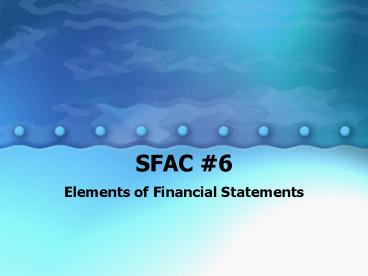SFAC PowerPoint PPT Presentation
1 / 20
Title: SFAC
1
SFAC 6
- Elements of Financial Statements
2
Assets
- Probable future economic benefits
- Obtained or controlled by a particular entity
- Result of past transactions or events.
3
Liabilities
- Probable future sacrifices of economic benefits
- Arising from present obligations to transfer
assets or provide services to other entities in
the future - Result of past transactions or events.
4
Equity
- A.k.a. net assets
- Residual interest in assets of an entity after
deducting its liabilities. - In a business enterprise, the equity is the
ownership interest. - In a not-for-profit organization, divided into
three classes based on the presence or absence of
donor-imposed restrictions - permanently restricted
- temporarily restricted
- unrestricted net assets.
5
Investments by owners
- Increases in equity resulting from transfers to
it from other entities of something valuable to
obtain or increase ownership interests (or
equity) in it. - Assets are most commonly received as investments
- May also include services
- May include satisfaction or conversion of
liabilities.
6
Distributions to owners
- Decreases in equity resulting from transferring
assets, rendering services, or incurring
liabilities to owners. - Distributions to owners decrease ownership
interest (or equity) in an enterprise.
7
Comprehensive income
- Change in equity of a business enterprise during
a period from transactions and other events and
circumstances from nonowner sources. - All changes in equity except those resulting from
investments by owners and distributions to
owners.
8
Comprehensive Income Results From
- exchange transactions and other transfers between
the enterprise and other entities that are not
its owners - enterprise's productive efforts
- price changes, casualties, and other effects of
interactions between the enterprise and the
economic, legal, social, political, and physical
environment of which it is part.
9
Earnings
- Not defined in this Statement.
- FASB Concepts Statement 5 has now described
earnings for a period as excluding certain
cumulative accounting adjustments and other
nonowner changes in equity that are included in
comprehensive income for a period.
10
Revenues
- Inflows or other enhancements of assets of an
entity or settlements of its liabilities (or a
combination of both) - Comes from delivering or producing goods,
rendering services, or other activities that
constitute the entity's ongoing major or central
operations.
11
Expenses
- Outflows or other using up of assets or
incurrences of liabilities (or a combination of
both) from delivering or producing goods,
rendering services, or carrying out other
activities that constitute the entity's ongoing
major or central operations.
12
Gains
- Increases in equity (net assets) from peripheral
or incidental transactions of an entity - From all other transactions and other events and
circumstances affecting the entity except those
that result from revenues or investments by
owners.
13
Losses
- Decreases in equity (net assets) from peripheral
or incidental transactions of an entity - From all other transactions and other events and
circumstances affecting the entity except those
that result from expenses or distributions to
owners.
14
SFAC 6 versus SFAC 3
- This Statement replaces FASB Concepts Statement
No. 3, Elements of Financial - Statements of Business Enterprises
- Extends that 3s definitions to not-for-profit
organizations.
15
Pacioli Anyone?
- Resources or assets are the lifeblood of a
not-for-profit organization - An organization cannot long continue to achieve
its operating objectives unless it can obtain at
least enough resources to provide goods or
services at levels and of a quality that are
satisfactory to resource providers. - Organizations that do not provide adequate goods
or services often find it increasingly difficult
to obtain the resources they need to continue
operations.
16
Types of Elements
- Two different types, which are sometimes
explained as being analogous to photographs and
motion pictures. - The elements defined in this Statement include
three of one type and seven of the other. - Guesses Anyone?
17
Effects of Uncertainty
- Uncertainty about economic and business
activities and results is pervasive - Often clouds whether a particular item qualifies
as an asset or a liability at the time - Effect of uncertainty is to increase the costs of
financial reporting - Definitions in this Statement are not intended to
require that the existence and amounts of items
be certain - Estimates and approximations will often be
required unless financial statements are to be
restricted to reporting only cash transactions
18
Transactions, Events, and Circumstances
- Transaction is an external event involving
transfer of something of value (future economic
benefit) between two (or more) entities. - Event is a happening of consequence to an entity.
- internal event that occurs within an entity, such
as using raw materials or equipment in production - external event
- Circumstances are a set of conditions that
develop from a series of events
19
Accrual Accounting
- Attempts to record the financial effects in the
periods in which those transactions, events, and
circumstances occur - Rather than only in the periods in which cash is
received or paid by the entity. - Based on
- cash transactions
- credit transactions
- barter exchanges
- nonreciprocal transfers of goods or services
- changes in prices
- changes in form of assets or liabilities
- other transactions, events, and circumstances
20
Realization and Recognition
- Realization means the process of converting
noncash resources and rights into money - Related terms realized and unrealized therefore
identify revenues or gains or losses on assets
sold and unsold - Recognition is the process of formally recording
or incorporating an item in the financial
statements - Realization and recognition are not used as
synonyms

